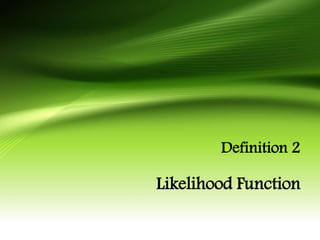
Likelihood Function Definition
- 1. Definition 2 Likelihood Function
- 2. Likelihood function • The Likekihood function of a random variables X1,X2,...,Xn is defined to be the joint density of the n random variables, say fx1,...,xn(x1,...,xn; Θ) , which is considered to be a function of Θ. In particular, if X1,...,Xn is a random sample from the density f (x; Θ) , then the likelihood function is f (x1; Θ)f (x2; Θ).....f (xn; Θ) . ///
- 3. • In statistics, the likelihood function (often simply the likelihood) is a function of the parameters of a statistical model that plays a key role in statistical inference. • but, in statistical usage, a clear technical distinction is made: the probability of some observed outcomes given a set of parameter values is referred to as the likelihood of the set of parameter values given the observed outcomes.
- 4. 1.the likelihood function is a function. 2.the likelihood function is not a probability density function. 3.if the data are iid then the likelihood is ___________ iid case only. 4.the likelihood is only defined up to constant of propotionality. 5.the likelihood function is used (i) to generate estimators (the maximum likelihood estimator) and (ii) as a key ingredient in Bayesian inference.
- 5. • Mathematically, writing X for the set of observed data and Θ for the set of parameter values, the expression P(X | Θ), the probability of X given Θ, can be interpreted as the expression L( Θ| X) , the likelihood of Θ given X. The interpretation of L( Θ | X) as a function of Θ is especially obvious when X is fixed and Θ is allowed to vary.
- 6. • Generally, L(Θ | X) is permitted to be any positive multiple of P(X | Θ). More precisely then, a likelihood function is any representative from an equivalence class of functions, • where the constant of proportionality α > 0 is not permitted to depend upon Θ. In particular, the numerical value L(Θ | X) alone is immaterial; all that matters are likelihood ratios, such as those of the form that are invariant with respect to the constant of proportionality α.
- 7. Notation • To remind ourselves to think of the likelihood function as a function of Θ, we shall use the notation L( Θ;x1,...,xn) or L(.;x1,...,xn) for the function. ///
- 8. The Likelihood Principle • An informal summary of the likelihood principle may be that inferences from data to hypotheses should depend on how likely the actual data are under competing hypotheses, not on how likely imaginary data would have been under a single "null" hypothesis or any other properties of merely possible data. • Bayesian inferences depend only on the probabilities assigned due to the observed data, not due to other data that might have been observed.
- 9. • A more precise interpretation may be that inference procedures which make inferences about simple hypotheses should not be justified by appealing to probabilities assigned to observations that have not occurred. • The usual interpretation is that any two probability models with the same likelihood function yield the same inference for θ.
- 10. Difference of Probability and Likelihood • 1.“Probability” and “likelihood” can be both used to express a prediction and odds of occurrences. • 2.“Probability” refers to a “chance” while likelihood refers to a “possibility.” • 3.A probability follows clear parameters and computations while a likelihood is based merely on observed factors.
- 11. End of the slide Thank you for listening :)
- 12. Definition • Let Xn=(x1,..,xn) have joint density p(xn; Θ)=P(x1,...,xn; Θ) where Θ ∈Θ. The likelihood function L :Θ [0, ∞) is defined by L( Θ) = L( Θ;xn) where xn is fixed and Θ varies in Θ.
Editor's Notes
- formula in 3 .,.,. write on the board.
- .,.in philosopically speaking the two words the same denotative meaning .Then again, these two words are strictly used in different contexts.